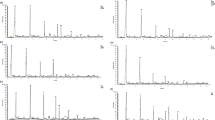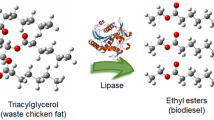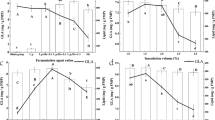Abstract
The increasing rise in the production of meat around the world causes a significant generation of agro-industrial waste—most of it with a low value added. Fatty wastes have the potential of being converted into biodiesel, given the overcome of technological and economical barriers, as well as its presentation in solid form. Therefore, the aim of this work was to investigate the capacity of Staphylococcus xylosus strains to modify the chemical structure of chicken fatty wastes intending to reduce the melting points of the wastes to mild temperatures, thereby breaking new ground in the production of biodiesel from these sources in an economically attractive and sustainable manner. The effects in time of fermentation and concentration of the fat in the medium were investigated, assessing the melting point and profile of fatty acids. The melting temperature showed a decrease of approximately 22 °C in the best operational conditions, due to reduction in the content of saturated fatty acids (high melting point) and increase of unsaturated fatty acids (low melting point).


Similar content being viewed by others
References
American Oil Chemists Society—AOCS (2009) AOCS official method Cj, pp 1–94
An H, Wilhelm WE, Searcy SW (2011) Biofuel and petroleum-based fuel supply chain research: a literature review. Biomass Bioenergy 35:3763–3774
Bajpai D, Tyagi VK (2006) Biodiesel: source, production, composition, properties and its benefits. J Oil Sci 55:487–502
Bavelaar FJ, Beynen AC (2003) Relationships between dietary fatty acid composition and either melting point or fatty acid profile of adipose tissue in broilers. Meat Sci 64:133–140
Bi Y, Ding D, Wang D (2010) Low-melting-point biodiesel derived from corn oil via urea complexation. Bioresour Technol 101:1220–1226
Brod FCA, Pelisser MR, Bertoldo JB, Vernal J, Bloch C Jr, Terenzi H, Arisi ACM (2010) Heterologous expression and purification of a heat-tolerant Staphylococcus xylosus lipase. Mol Biotechnol 44:110–119
Carriquiry MA, Du X, Timilsina GR (2011) Second generation biofuels: economics and policies. Energy Policy 39:4222–4234
Cengiz O, Sehmus A (2009) Biodiesel production from inedible animal tallow and a experimental investigation of its use as an alternative fuel in a direct injection diesel engine. Appl Energy 86:14–20
Demirbas MF, Balat M, Balat H (2011) Biowastes-to-biofuels. Energy Convers Manag 52:1815–1828
EN 14103—EN Standards (2011) Fat and oil derivatives—fatty acid methyl esters (FAME)—determination of Ester and linolenic acid methyl ester contents
Feng X, Patterson DA, Balaban M, Emanuelsson EAC (2013) Characterization of tributyrin hydrolysis by immobilized lipase on woolen cloth using conventional batch and novel spinning cloth disc reactor. Chem Eng Res Des 91:1684–1692
Fiegler H, Bruckner R (1997) Identification of the serine acetyltransferase gene of Staphylococcus xylosus. FEMS Microbiol Lett 148:181–187
Fiorentini AM, Sawitzki MC, Bertol TM, Sant’Anna ES (2009) Viability of Staphylococcus xylosus isolated from artisanal sausages for application as starter cultures in meat products. Braz J Food Microbiol 40:129–133
Food and agriculture organization of the united nations – FAO (2014) The state of food insecurity in the world 2014. FAO, Rome
Gupta R, Gupta N, Rathi P (2004) Bacterial lipases: an overview of production, purification and biochemical properties. Appl Microbiol Biotechnol 31:763–781
Guru M, Koca A, Can O, Çinar C, Sahin F (2010) Biodiesel production from waste chicken fat based sources and evaluation with Mg based additive in a diesel engine. Renew Energy 35:637–643
Havlik P, Schneider UA, Schmid E et al (2011) Global land-use implications of first and second generation biofuel targets. Energy Policy 39:5690–5702
Jang Y, Park JM, Choi S, Choi YJ, Seung DY, Cho JH, Lee SY (2012) Engineering of microorganisms for the production of biofuels and perspectives based on system metabolic engineering approaches. Biotechnol Adv 30:989–1000
Jolliffe IT (2002) Principal component analysis, 2nd edn. Springer, New York
Joshi RM, Pegg MJ (2007) How properties of biodiesel fuel blends at low temperatures. Fuel 86:143–151
Knothe G, Dunn RO (2009) A comprehensive evaluation of the melting points of fatty acids and esters determined by differential scanning calorimetry. J Am Oil Soc 86:843–856
Kozacinski L, Drosinos E, Caklovica F, Cocolin F, Gasparik-Reichardt J, Veskovic S (2008) Investigation of microbial association of traditionally fermented sausages. Food Technol Biotechnol 46:93–106
Mauriello G, Casaburi A, Blaiotta G, Villani F (2004) Isolation and technological properties of coagulase negative staphylococci from fermented sausages of Southern Italy. Meat Sci 67:149–158
Mosbah H, Sayari A, Bezzine S, Gargouri Y (2006) Expression, purification, and characterization of His-tagged Staphylococcus xylosus lipase wild-type and its mutant Asp 290 Ala. Protein Expr Purif 47:516–523
Naik SN, Goud VV, Rout PK, Dalai AK (2010) Production of first and second generation biofuels: a comprehensive review. Renew Sustain Energy Rev 14:578–597
Nigan PS, Singh A (2011) Production of liquid biofuels from renewable resources. Prog Energy Combust Sci 37:52–68
Olesen PT, Stahnke LH (2004) The influence of environmental parameters on the catabolism of branched-chain amino acids by Staphylococcus xylosus and Staphylococcus carnosus. Food Microbiol 21:43–50
Organization for economic co-operation and development of the united nations-OECD, food and agriculture organization of the united nations-FAO (2014) Agricultural outlook 2014–2023: meat. FAO, Rome
Santori G, Di Nicola G, Moglie M, Polonara F (2012) A review analyzing the industrial biodiesel production practice starting from vegetable oil refining. Appl Energy 92:109–132
Sarin A, Arora R, Singh NP, Sarin R, Malhotra RK, Kundu K (2009) Effect of blends of Palm-Jatropha-Pongamia biodiesels on cloud point and pour point. Energy 34:2016–2021
Sharma M, Singh SS, Mann P, Sharma M (2014) Biocatalytic potential of lipase from Staphylococcus sp. MS1 for transesterification of jatropha oil into fatty acid methyl esters. World J Microbiol Biotechnol 30:2885–2897
Xue J, Grift TE, Hansen AC (2011) Effect of biodiesel on engine performances and emissions. Renew Sustain Energy Rev 15:1098–1116
Zhao X, Qi F, Yuan C, Du W, Liu D (2015) Lipase-catalyzed process for biodiesel production: enzyme immobilization, process simulation and optimization. Renew Sustain Energy Rev 44:182–197
Author information
Authors and Affiliations
Corresponding author
Electronic supplementary material
Below is the link to the electronic supplementary material.
Rights and permissions
About this article
Cite this article
Marques, R.V., Duval, E.H., Corrêa, L.B. et al. Increase of Unsaturated Fatty Acids (Low Melting Point) of Broiler Fatty Waste Obtained Through Staphylococcus xylosus Fermentation. Curr Microbiol 71, 601–606 (2015). https://doi.org/10.1007/s00284-015-0890-y
Received:
Accepted:
Published:
Issue Date:
DOI: https://doi.org/10.1007/s00284-015-0890-y




